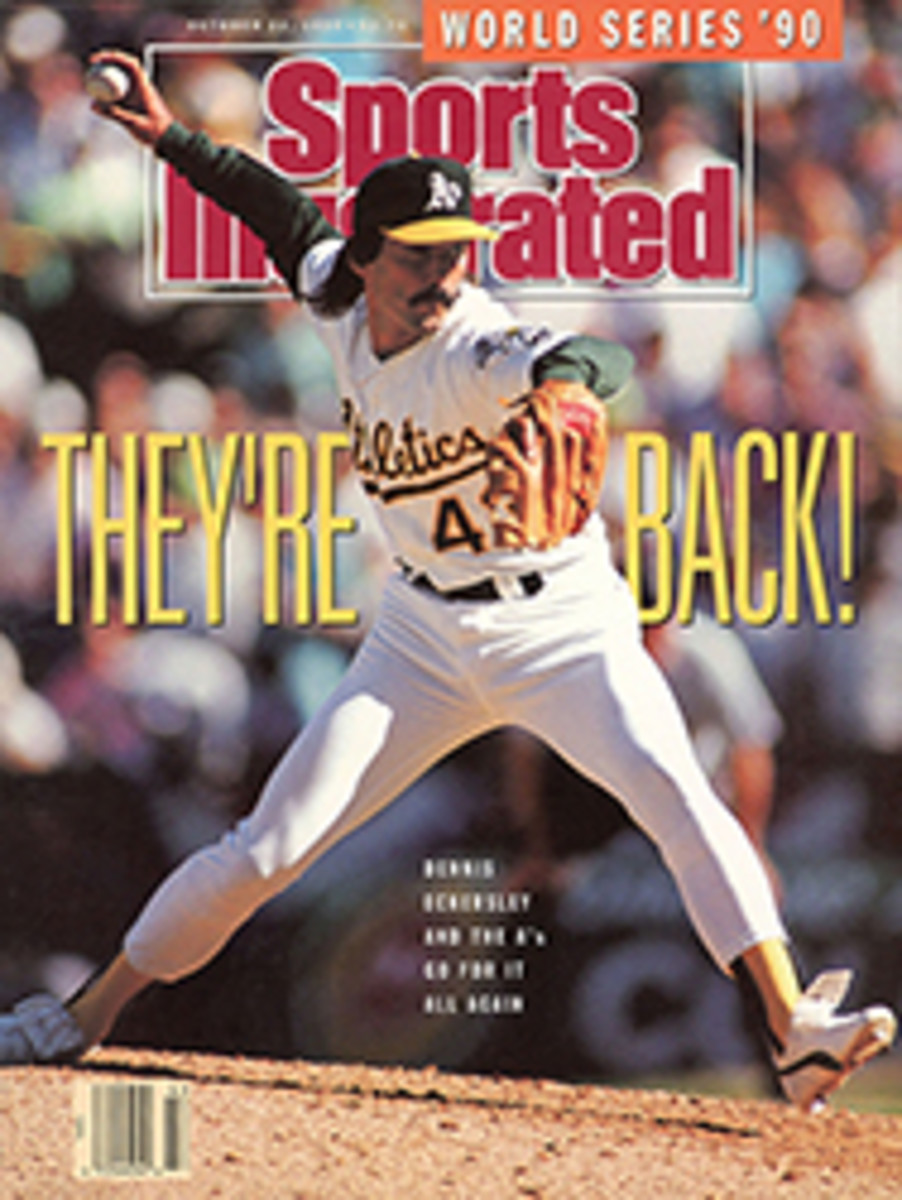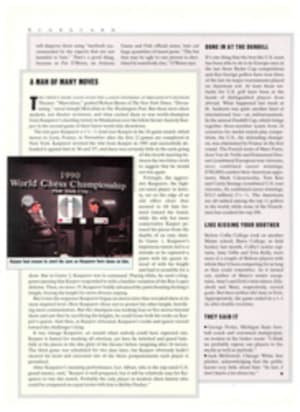
SCORECARD
CONTROL PROBLEMS
It was an incident that hurt both the Red Sox and baseball's image. In last week's fourth and final game of the American League playoff between Boston and Oakland, Red Sox ace Roger Clemens was ejected in the second inning by home plate umpire Terry Cooney. The Rocket shook his head after walking a batter, and Cooney shouted to him, "You better not be shaking your head at me." Whereupon Clemens unleashed several choice words that historically have resulted in a player's ejection. Whereupon Cooney tossed Clemens.
Much subsequent discussion focused on whether Cooney should have ejected Clemens from such an important game without issuing a warning. Certainly Cooney should not have instigated a near riot, which he did because of his haste in thumbing Clemens. The umpire's job is to control the game, but nowadays far too many umps react to the slightest provocation. The commissioner's office should address this before signing a labor agreement with the umpires' association this winter.
As for Clemens, his control problem is not one involving balls and strikes. The day before the season ended, he punched a door with his pitching hand in an argument with team officials over the matter of when to allow reporters into the Boston clubhouse. Clemens pitched six shutout innings in the first playoff game with Oakland but ignored the press afterward. The next night he screamed at home plate umpire John Hirschbeck and then threw a roll of tape and a towel against the dugout wall. Later in the game, Clemens taunted A's pitcher Bob Welch, a recovering alcoholic, about Welch's drinking problem, and when manager Joe Morgan told him to lay off, Clemens turned on Morgan. During Game 3, Clemens bellowed from the dugout after disagreeing with a close call by Cooney at first. Perhaps it was just the postseason atmosphere. But by all appearances, Clemens's problems run deeper than simple stress.
Clemens has immense talent and a good reputation. His agent, Hendricks Management, should do all it can to protect those assets. Baseball needs The Rocket. Baseball also needs umpires who don't set off rockets.
BATTY GOINGS-ON
Since its opening in 1929, Arizona Stadium has served an array of purposes in addition to its primary one as the home of University of Arizona football. The 56,136-seat building today contains student dorms, tree-ring-research and optics labs and a printing center. This fall, a stadium club restaurant was to open there as well, catering to football fans who paid a $150 membership fee. But trouble arose when another group of stadium residents began visiting the club without applying for membership.
Just before the Wildcats' home opener against Illinois on Sept. 8, the Pima County Health Board criticized the restaurant because the floor was covered with bat guano. Thousands of tiny bats inhabit the stadium, and some of them were found to be living in an expansion joint above the restaurant. University employees sprayed carbon dioxide into the crack hoping to force the bats out so the crack could be sealed. Instead, many of the bats were stunned and fell to their deaths. The next day a pest-controller was called in to spray a nontoxic, latex compound into the crack. The thinking here was that the leftover bats would go when they couldn't grip the coated concrete. There were further sprayings over the next two weeks, and at least one more bat died.
The baticide enraged Ronnie Sidner, a Ph.D. candidate in biology and ecology at Arizona and an expert on southwestern bats. Sidner was well acquainted with the stadium's bats, having once spent 50 straight evenings observing a falcon feeding on them. "Biologists don't get to see death take place in the wild very often," she says. In Sidner's view, while it's fine for a falcon to kill bats, it's another matter when people do so. In fact, bats are a protected species in Arizona, and killing them is a misdemeanor.
Sidner and another Tucson woman, Mary Schanz, who belongs to the 10,000-member Bat Conservation International, raised objections to the university's handling of the bat infestation. They claimed that more than 100 bats had died, while university officials have put the figure far lower. Last week the Arizona Game and Fish Department agreed with the women and brought a complaint to the county attorney's office that could lead to the university's being fined a maximum of $20,000 for each dead bat.
The club now boasts a suitably hygienic ambience, and assistant athletic director Dick Bartsch says that if the bats return to the area, the university will disperse them using "methods recommended by the experts that are not harmful to bats." That's a good thing, because as Pat O'Brien, an Arizona Game and Fish official notes, bats eat huge quantities of insect pests. "The bat that may be ugly to one person is cherished by somebody else," O'Brien says.
DONE IN AT THE DUNHILL
It's one thing that the best the U.S. team has been able to do is tie Europe once in the last three Ryder Cup competitions and that foreign golfers have won three of the last six major tournaments played on American soil. At least those setbacks for U.S. golf have been at the hands of distinguished players from abroad. What happened last week at St. Andrews was quite another kind of international loss—an embarrassment. In the annual Dunhill Cup, which brings together three-member teams from 16 countries for medal match-play competition, the U.S., the defending champion, was eliminated by France in the first round. The French team of Marc Farry, Jean Van de Velde and Emmanuel Dussart (combined European tour victories, zero; combined career winnings, $700,000) outshot their American opponents, Mark Calcavecchia, Tom Kite and Curtis Strange (combined U.S. tour victories, 36; combined career winnings, $14.5 million) 2½-½. The Americans are all ranked among the top 11 golfers in the world, while none of the Frenchmen has cracked the top 200.
LIKE KISSING YOUR BROTHER
Before Colby College took on another Maine school, Bates College, in field hockey last month, Colby's senior captains, Amy Gillis and Erin Kelly, were wary of a couple of Bobcat players with whom they'd been competing for as long as they could remember. As it turned out, neither of Bates's senior cocaptains, Amy's and Erin's twin sisters, Elizabeth and Mary, respectively, scored goals. But then neither did Amy or Erin. Appropriately, the game ended in a 1-1 tie after double overtime.
A MAN OF MANY MOVES
The critics were agog over the latest offering at Broadway's Hudson Theater. "Marvelous," gushed Robert Byrne of The New York Times. "Devastating," raved Joseph McLellan in The Washington Post. But these were chess analysts, not theater reviewers, and what excited them so was world-champion Gary Kasparov's dazzling victory in Manhattan over his fellow Soviet Anatoly Karpov in the second game of their latest world-title showdown.
The win gave Kasparov a 1½-½ lead over Karpov in the 24-game match, which moves to Lyon, France, in November after the first 12 games are completed in New York. Kasparov wrested the title from Karpov in 1985 and successfully defended it against him in '86 and '87, and there was certainly little in the early going of this fourth meeting between the two bitter rivals to suggest that he would not win again.
Fittingly, the aggressive Kasparov, the highest-rated player in history, sat on the edge of an old office chair that seemed to tilt him forward toward the board, while the wily but more conservative Karpov perused his pieces from the depths of an easy chair. In Game 1, Kasparov's impetuous nature led to a mistake as he captured a pawn with his queen instead of with his knight and had to scramble for a draw. But in Game 2, Kasparov was in command. Playing white, he used a king-pawn opening that Karpov responded to with a familiar variation of the Ruy Lopez defense. Then, on move 19, Kasparov boldly advanced the pawn fronting his king's knight, freeing the knight for more diverse sniping.
But it was the sequence Kasparov began six moves later that revealed chess at its most inspired level. Here Kasparov chose not to protect his other knight, horrifying most commentators. But the champion was looking four or five moves beyond them and saw that by sacrificing his knights, he could loose both his rooks on Karpov's queen. And then, as Karpov retreated, Kasparov's rooks and queen veered toward the challenger's king.
It was vintage Kasparov, an assault when nobody could have expected one. Karpov is famed for masking all emotion, yet here he twitched and gazed bale-fully at his pieces in the dim glow of the theater before resigning after 44 moves. The third game was scheduled for two days later, but Karpov obviously hadn't cleared his head and exercised one of the three postponements each player is permitted.
After Kasparov's stunning performance, Lev Alburt, who is the top-rated U.S. grand master, said, "Karpov is well prepared, but it will be relatively easy for Kasparov to win this match. Probably the only player in modern chess history who could be compared on equal terms with him is Bobby Fischer."
ILLUSTRATION
PATRICK MCDONNELL
PHOTO
TASS/SVETLANA MOSTOVETS
Karpov had reason to avert his eyes as Kasparov bore down on him.
THEY SAID IT
•George Perles, Michigan State football coach and renowned malapropist, on women in the locker room: "I think we probably expose our players to the media as well as anybody."
•Jack McDowell, Chicago White Sox pitcher, acknowledging that the public knows very little about him: "In fact, I don't know a lot about me."

